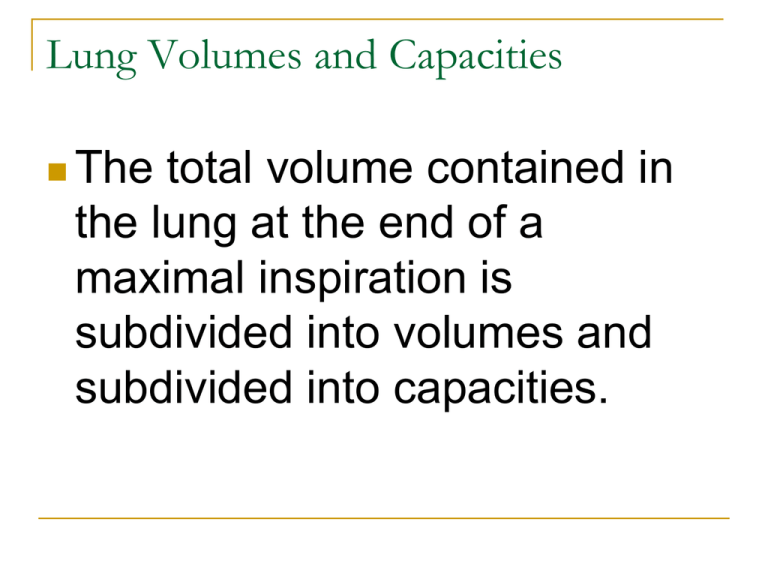Lung Volumes and Capacities
advertisement

Lung Volumes and Capacities The total volume contained in the lung at the end of a maximal inspiration is subdivided into volumes and subdivided into capacities. There are 4 volume subdivisions They do not overlap They can not be further divided When added together equal total lung capacity Lung Capacities Are subdivisions of the total volume that include two or more of the 4 basic lung volumes Basic Lung Volumes Tidal Volume: TV The amount of gas inspired or expired with each normal breath. About 500 ml Basic Lung Volumes Inspiratory Reserve Volume: IRV Maximum amount of additional air that can be inspired from the end of a normal inspiration. Basic Lung Volumes Expiratory Reserve Volume: ERV The maximum volume of additional air that can be expired from the end of a normal expiration. Basic Lung Volumes Residual Volume: RV The volume of air remaining in the lung after a maximal expiration. This is the only lung volume which cannot be measured with a spirometer. Gas dilution tech nitrogen helium Body Plethysmograph Lung Capacities Total Lung Capacity: TLC The volume of air contained in the lungs at the end of a maximal inspiration. Called a capacity because it is the sum of the 4 basic lung volumes TLC= RV+IRV+TV+ERV Lung Capacities Vital Capacity: VC The maximum volume of air that can be forcefully expelled from the lungs following a maximal inspiration. Called a capacity because it is the sum of inspiratory reserve volume, tidal volume and expiratory reserve volume. VC= IRV+TV+ERV = TLC - RV Lung Capacities Functional Residual Capacity: FRC The volume of air remaining in the lung at the end of a normal expiration. Called a capacity because it equal residual volume plus expiratory reserve volume. FRC= RV+ERV Lung Capacities Inspiratory Capacity: IC Maximum volume of air that can be inspired from end expiratory position. Called a capacity because it is the sum of tidal volume and inspiratory reserve volume. This capacity is of less clinical significance than the other three. IC= TV+IRV Respiratory Diseases Restrictive Disease: Makes it more difficult to get air in to the lungs. They “restrict” inspiration. Decreased VC; Decreased TLC, RV, FRC Includes: Fibrosis Sarcoidosis Muscular diseases Chest wall deformities Respiratory Diseases Obstructive Disease Make it more difficult to get air out of the lungs. Decrease VC; Increased TLC, RV, and FRC Includes: Emphysema Chronic bronchitis Asthma











